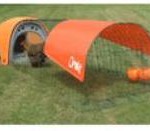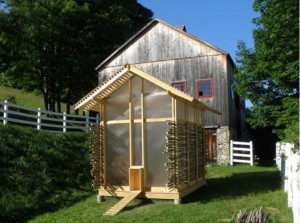Chickens make great pets and have the added bonus of providing fresh eggs every day. Just don’t let them see you doing the crossword puzzle because they will want to help when you go inside to get another cup of coffee. My pair of Araucanas even thought to use some ornamental cherries as ink!
When they aren’t doing the Sunday NYT Crossword, chickens love to follow you around the garden, stopping maybe to: eat an insect or two, graze on clover, rearrange the mulch, or dig a dust bowl and roll around making odd purring sounds. When you have free range chickens you cannot be too fussy about your garden.
That said, keeping chickens in your yard may be one of the simplest, healthiest, and most environmentally-sound activities you can undertake. Chickens need:
- A coop with a nesting box and some perches
- Feed that has a good vitamin/mineral mix
- Other food including table scraps
- A safe place(s) to protect them from varmints – hawks, eagles, foxes
Activities to keep them from becoming bored…note NYT…chickens love to explore, converse, kibitz, jump on things, read, fly around. Caged up they can get a little antsy and…loud.
- Here they are reading about Appreciative Inquiry.
How do you get started?
First make sure with your town/city/neighborhood that it is okay to keep chickens
I would suggest that you put aside the idea of incubating eggs – sounds like fun for the first day.
Getting teenage birds (pullets) sounds good – egg production starts sooner – but you will need to put up with any bad habits they learned from their flock. That may include: sleeping in trees (I dare you to try and get a chicken out of a tree once they have wrapped their feet around a branch), crowing (yes hens can yell as loud as a rooster crows), running away (hey, who the heck are you, not my mom)… The good things about juvenile birds are 1. You know whether you have a rooster or not and 2. You are very sure of the breed.
Chicks are cute and fun to raise. They never stop peeping but are very easy to keep in a box in your kitchen, mudroom or garage. By handling and playing with them, they will imprint on you (hey, you are my mother) and will most likely be well behaved as they grow up. Don’t expect eggs for about 9 months.


You can find pullets and chicks in the spring time at many farmer’s markets, some feed stores or you can order them by mail…yes, mail…but be prepared for the Post Master’s harried call telling you to get down to the Post Office ASAP so that the cheeping will stop.
Where Do They Live?
Outside – in a coop – with a protective fence.
There are some amazing coops out there – for sale and for you to build. We have a bright orange Omlet
which works great for two chickens but can quickly get crowded as the flock grows. Williams-Sonoma has a moveable chicken palace that is quite attractive.
Personally, I think the best coop design would:
- Be easily moveable.
- Provide lots of light for the chickens
- Provide good ventilation
- Have lots of perches at various heights
- Have nesting boxes that are easily accessed from the outside
- Be easy to clean up
- Be easy to hose down and dry out after cleaning
- Be tall enough for me to stand up inside accessed via a good sized people door
- Have water and feed containers that are east to access from the outside
- Be easy to warm up in the winter
- Have a good strong chicken access door that is easy for me to open but baffling to raccoons and foxes
This one not only fits all of those criteria, it makes an architectural statement.
Have fun with your chickens and they will reward you with friendship, gardening assistance and eggs.

